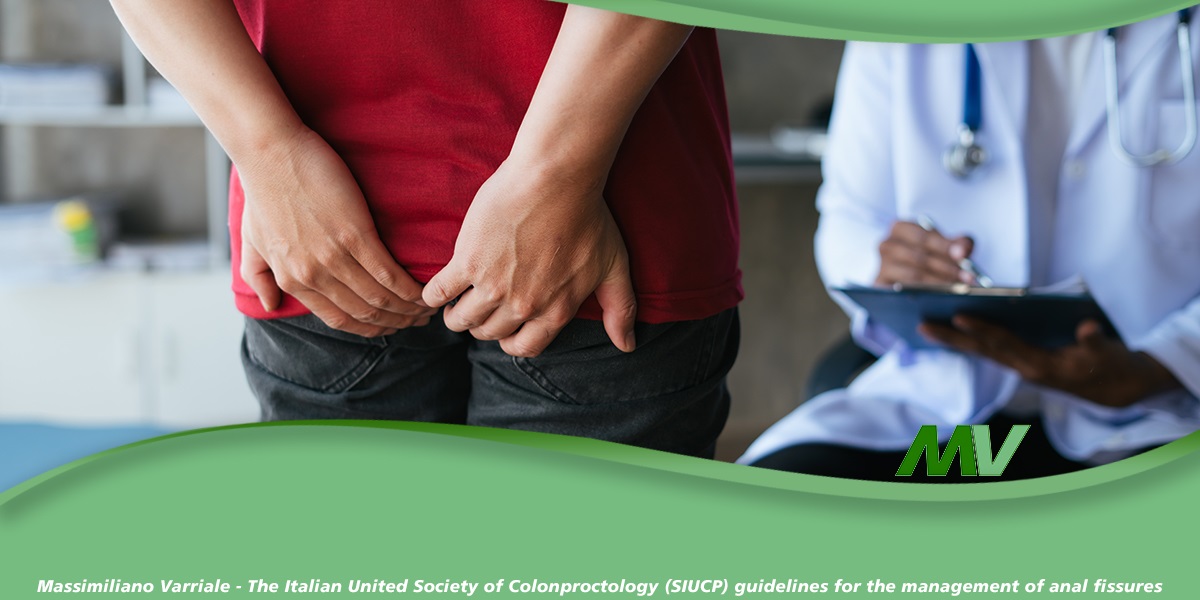The Italian United Society of Colonproctology (SIUCP) guidelines for the management of anal fissures
The purpose of the evidence-based guidelines is to present a consensus position by members of the Italian Unitary Society of Colon-Proctology (SIUCP: Società Italiana Unitaria di Colon-Proctologia) on the diagnosis and management of anal fissure, with the aim of guiding each physician in choosing the best treatment option, in accordance with the available literature.
A group of experts was designed and commissioned by the SIUCP Board to develop key questions on the main topics concerning the management of anal fissures and to perform a thorough search on each topic in several databases in order to provide evidence-based answers to the questions and summarize them in statements.
All clinical questions were discussed by the expert panel in different rounds through the Delphi approach, and for each statement, a consensus was reached among the experts. The questions were created according to PICO criteria, and the statements were developed by adopting the GRADE methodology.
In patients with acute anal fissure, medical therapy with dietary and behavioral regulations is indicated. In the chronic phase of the disease, conservative treatment with topical nifedipine 0.3 percent plus lidocaine or nitrates 1.5 percent may be the first-line therapy, possibly combined with ointments with film-forming, anti-inflammatory and healing properties such as Propionibacterium extract gel. If first-line treatment fails, the surgical strategy (internal sphincterotomy or fissurectomy with flap), may be guided by clinical findings, possibly supported by endoanal ultrasound and anal manometry.
In patients with anal fissure, what are the appropriate morphological investigations?
- Based on the limited available literature, no recommendation can be made regarding the use of imaging investigations in patients with typical acute anal fissure, especially in the presence of anal pain and spasm that make it difficult to perform any endoanal examination.
- In patients with atypical anal fissures, especially when associated pathology including inflammatory bowel disease or colorectal and anal cancer is suspected, imaging investigations such as colonoscopy, anoscopy, and endoanal ultrasound may be useful for diagnostic purposes (weak recommendation based on low-quality evidence, 2C).
- In patients with chronic anal fissure poorly responsive to medical therapy, in order to assess the presence of associated occult anal sepsis, morphologic evaluation with endoanal ultrasound may be considered (weak recommendation based on low-quality evidence, 2C).
- In patients with chronic anal fissure and suspected occult local sepsis, if endoanal ultrasound is not available, MRI may be considered as an alternative diagnostic tool (expert opinion)
In patients with anal fissure, what are the appropriate functional investigations?
- Based on the available literature, no recommendation can be made regarding the use of functional investigations such as anorectal manometry in patients with acute anal fissure. Commonly, anorectal physiology tests are not routinely performed at this juncture, and the initial assessment of sphincter hypertonia in patients with anal fissure could be based on clinical examination (expert opinion).
- In patients with chronic anal fissure poorly responsive to medical therapy, in order to accurately select patients without internal sphincter hypertonia, an anorectal manometric evaluation may be considered (weak recommendation based on low-quality evidence, 2C).
- Although anal manometry can detect anal tone more accurately than digital rectal exploration, this functional investigation is not always feasible in patients with chronic hyperalgesic fissure. If manometry is not feasible or available, assessment of anal tone with digital examination may be considered sufficient (expert opinion)
In patients with acute anal fissure, what is the treatment of choice?
- In patients with acute anal fissure, nonsurgical management should be considered as first-line treatment, while surgical treatment can be considered in the chronic phase, in patients who do not respond after at least 6 weeks of conservative treatment (strong recommendation based on moderate-quality evidence, 1B).
- Nonsurgical management in patients with acute anal fissure should include warm semicups and increased dietary fiber and water intake until soft stools are achieved (strong recommendation based on moderate-quality evidence, 1B).
- In cases of persistent hard stools, fiber supplements and mass-forming laxatives can be added to therapy (expert opinion)
- In patients with acute anal fissure, adjunctive therapy with topical application of sphincter relaxants such as calcium channel blockers and, in particular, 0.3 percent nifedipine plus 1.5 percent lidocaine may be considered in case of poor patient adherence to dietary and behavioral medical prescriptions (weak recommendation based on low-quality evidence, 2C).
- Supplementation of topical metronidazole in the nonsurgical management of acute anal fissure may be considered (weak recommendation based on low-quality evidence, 2C).
- The additional use of common analgesic drugs, topical anesthetics, and ointments with thermogenic and muscle relaxant effect in the treatment of acute anal fissure is reasonable in case of inadequate pain control (expert opinion).
- In cases of acute hyperalgesic anal fissure not responsive to common pain relievers and ointments, a surgical approach may be considered in emergency settings (expert opinion)
- Self-induced gradual mechanical anal dilation with dedicated plastic dilators is commonly suggested and prescribed for patients with anal sphincter hypertonia and spasm. However, due to the lack of relevant literature, it is not possible to make recommendations regarding this treatment in patients with anal fissure.
In patients with chronic anal fissure, what is the first-line treatment?
- In patients with chronic anal fissure and typical clinical presentation (severe anal pain associated with suspected anal sphincter hypertonia on objective examination), topical application of calcium channel blockers or nitrates (0.4% glyceryl trinitrate) may be the first-line treatment (strong recommendation based on moderate-quality evidence, 1B).
- Topical use of calcium channel blockers is associated with similar efficacy and fewer side effects, compared with nitrates. (Strong recommendation based on moderate-quality evidence, 1B).
- In patients with chronic anal fissure and typical clinical presentation, topical therapy of 0.3% nifedipine plus 1.5% lidocaine may be considered as first-line therapy (weak recommendation based on moderate-quality evidence, 2B).
- The additional use of topical ointments with curative properties in the treatment of chronic anal fissure may be reasonable in combination with topical calcium channel blockers and nitrates in cases of anal sphincter hypertonia or as an exclusive treatment in cases of anal sphincter hypotonia (expert opinion).
- Among topical ointments with film-forming, anti-inflammatory and healing properties, Propionibacterium extract gel (PeG) may be considered (weak recommendation based on moderate-quality evidence, 2B).
In patients with chronic anal fissure, what is the role of botulinum toxin injection?
- In patients with chronic anal fissure, botulinum toxin injection shows comparable results to topical nitroglycerin as first-line therapy (strong recommendation based on moderate-quality evidence, 1B).
- In patients with chronic anal fissure, botulinum toxin injection may be considered as second-line therapy after unsuccessful treatment with topical nitrates (weak recommendation based on low-quality evidence, 2C).
- The use of botulinum toxin injection in patients with chronic anal fissure is limited by the low uptake of the procedure and the heterogeneity of injection protocols adopted (expert opinion).
In patients with chronic anal fissure what is the role of anal dilatation?
- Uncontrolled anal dilatation is associated with a lower cure rate and higher risk of incontinence when compared with lateral internal sphincterotomy and therefore cannot be recommended (strong recommendation based on moderate-quality evidence, 1B)
- Pneumatic balloon dilation may be offered as a treatment option in patients with chronic anal fissure poorly responsive to medical therapy and associated with anal hypertonia (weak recommendation based on moderate-quality evidence, 2B)
- In the context of chronic anal fissure associated with anal hypertonia, pneumatic ballon anal dilatation may be preferred to sphincterotomy in multiparous female patients and in patients with previous documented sphincter damage or obstetric injury (weak recommendation based on moderate-quality evidence, 2B)
In patients with chronic anal fissure what is the role of sphincterotomy?
- Lateral internal sphincterotomy may be offered as a treatment option in patients with chronic anal fissure poorly responsive to medical therapy and associated with anal hypertonia (strong recommendation based on high-quality evidence, 1A).
- Within this group of patients, lateral internal sphincterotomy should be considered as the treatment of choice in individuals with no clinical complaints of fecal incontinence, no previous anorectal operations or trauma, and no previous sphincter injury or obstetric trauma (strong recommendation based on high-quality evidence, 1A).
- Lateral internal sphincterotomy should not be offered to patients with fecal incontinence at baseline or with a documented anal sphincter injury or obstetric trauma (strong recommendation based on high-quality evidence, 1A).
- Open and closed lateral internal sphincterotomy techniques show similar results (strong recommendation based on high-quality evidence, 1A).
What is the appropriate extent of sphincterotomy?
- A safe lateral internal sphincterotomy should be confined below the level of the serrated line (strong recommendation based on moderate-quality evidence, 1B)
- Lateral internal sphincterotomy adapted to the slot length is equally effective and safer than conventional sphincterotomy extended to the serrated line (strong recommendation based on high-quality evidence, 1A)
- In female patients, the ideal extension of the internal sphincter division should be between 5 and 9 mm of muscle, never exceeding 10 mm (strong recommendation based on low-quality evidence, 1C)
In patients with chronic anal fissure, what is the role of fissurotomy and fissurectomy?
- Based on the limited available literature, no recommendation can be made regarding the use of fissurotomy in the treatment of chronic anal fissure.
- Fissurectomy is inferior to lateral internal sphincterectomy in the treatment of chronic anal fissurectomy associated with internal anal sphincter hypertone (strong recommendation based on high-quality evidence, 1A)
- Fissurectomy may be considered in patients with chronic anal fissure associated with abscess or fistula and normotonic internal anal sphincter (weak recommendation based on low-quality evidence, 2C)
In patients with chronic anal fissure what is the role of the anocutaneous flap?
- In light of the low postoperative risk of incontinence, the anocutaneous flap may be considered as an alternative surgical option in patients with chronic anal fissure and high risk of incontinence after sphincterotomy (low anal pressure at rest, previous anal surgery or trauma, previous documented sphincter injury or obstetric trauma) (weak recommendation based on moderate-quality evidence, 2B).
- Adding an anocutaneous flap to sphincterotomy or botulinum toxin injection can reduce postoperative pain, improve healing rate, and reduce the rate of postoperative incontinence (weak recommendation based on low-quality evidence, 2C).
In patients with chronic anal fissure, what is the role of tibial nerve stimulation?
- Percutaneous tibial nerve stimulation may be considered as a potential alternative treatment for chronic anal fissure (weak recommendation based on low-quality evidence, 2C).
- Percutaneous tibial nerve stimulation may be considered as a potential treatment option for chronic anal fissure resistant to other conservative measures in patients who are unfit for surgery or who refuse surgical treatment (expert opinion)

